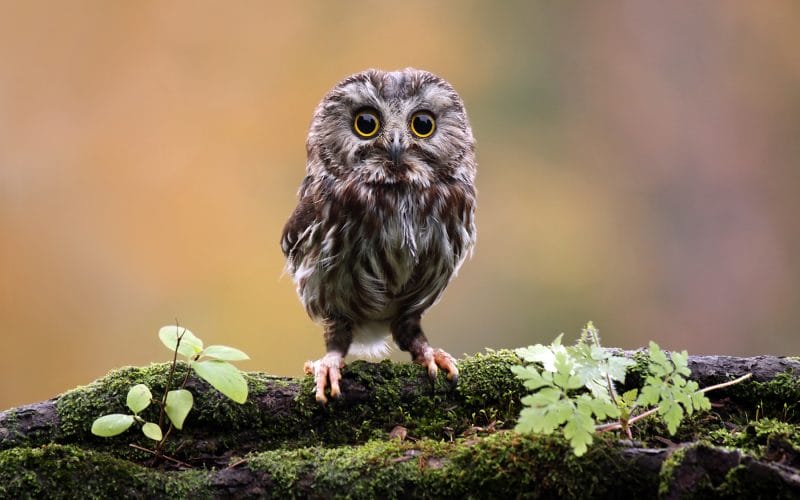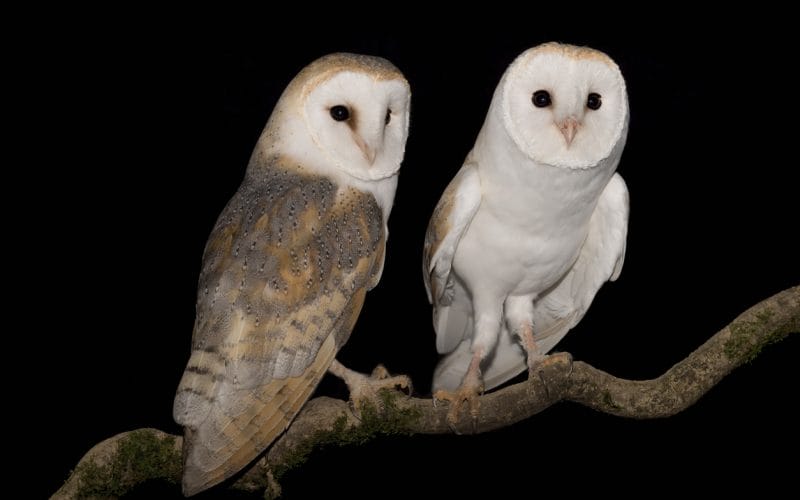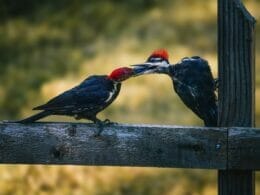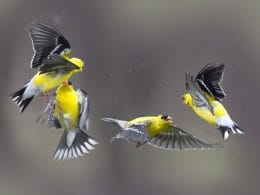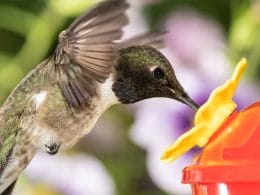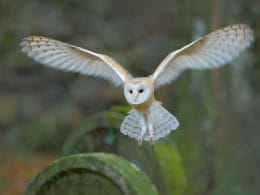If you’re into bird watching, you’re undoubtedly intrigued by the mysterious owls lurking out during the night and stalking their prey.
The thing is: owls aren’t the easiest birds to spot. They’re hyper-aware of their surroundings, thanks to their excellent authority senses.
Nevertheless, you can still enjoy sighting owls in Washington State if you know where and what to look for.
15 Owls in Washington State to Put on Your Birdwatch List:
Always keep in mind that owls are exceptionally good at hiding, which means that you have a better chance at hearing them before you spot them.
So, cup your ears, and let’s get ready to hear some resonating hoots!
1. The Great Horned Owl
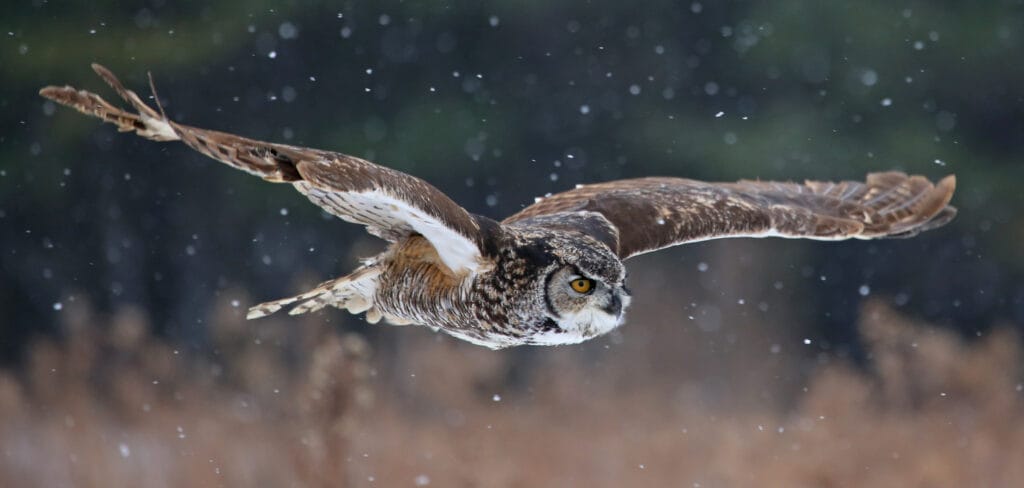
- Scientific name: Bubo virginianus
- Length: 17-25 in
- Wingspan: 4.6 ft
- Weight: 3 lb
Being extremely large and widely distributed all over Washington, the Great Horned Owl is one of the easiest species to spot.
Author Note: The elongated ear tufts almost look like extended eyebrows, which gives the owl a frowned look.
However, the Great Horned Owls are a force to be reckoned with.
They can take on prey that’s larger than themselves. Every once in a while, they might hunt down a cat.
While it’s easy to spot one of those in most Washington forests, you have to be careful because they will defend their territory, even against humans.
2. The Snowy Owl

- Scientific name: Bubo scandiacus
- Length: 24.8-28.7 in
- Wingspan: 4-5 ft
- Weight: 4.4 lb
It’s rare to spot a Snowy Owl in Washington. However, they sometimes appear briefly during their migration to Canada.
When they do appear, though, they quickly capture eyes. This one owl in Union Station turned to a social media sensation very quickly.
And that’s understandable.
There are a couple of unique features working here to make this owl look particularly appealing. Take, for instance, its yellow eyes on a solid-white face.
Your best odds of coming across this majestic white is at Whatcom County. Pay special attention to open fields.
3. The Screech-Owl
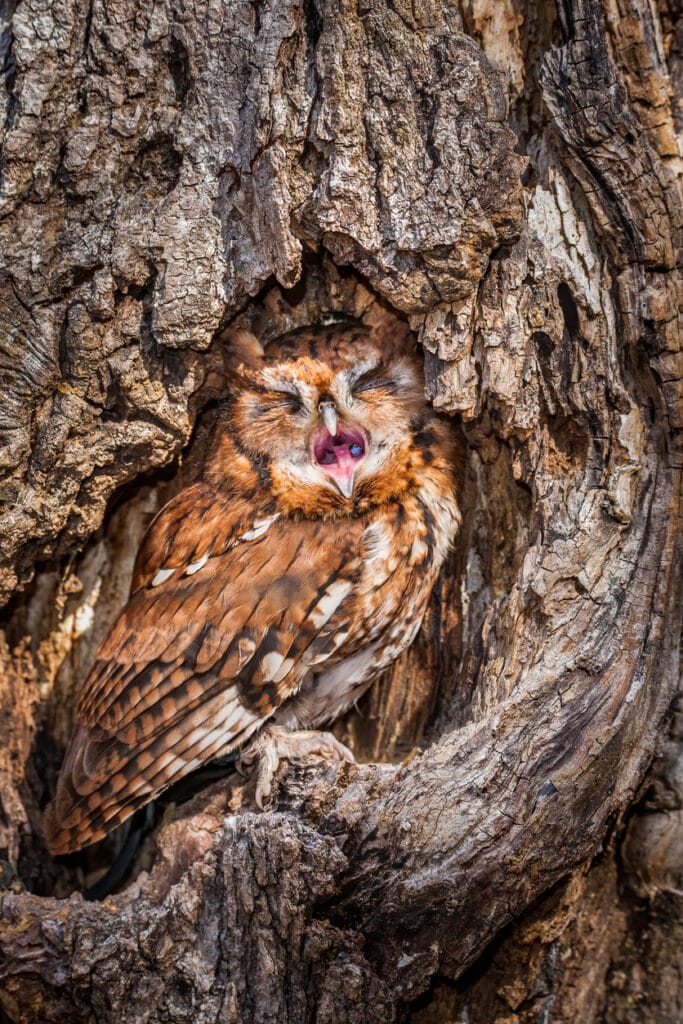
- Scientific name: Otus kennicottii and Otus asio
- Length: 7.5 in
- Wingspan: 18-24 in
- Weight: 0.35 lb
There are two main species of the Screech-Owls. The Otus asio is also called the Eastern Screech, while the Otus kennicottii is the Western Screech.
Both Screech-Owls are commonly spotted all over Washington all year round. You can tell the Western Screech apart from the Eastern Screech by its longer ear tuft.
You’ll have to look closely, though.
The brown and white patterned plumage helps the owl to camouflage and nest perfectly within tree barks.
Regardless of what the name implies, there’s nothing particularly screechy about either species. Their hoot is high-pitched with a bit of elevation at the end, but it’s not unpleasant to hear at all.
4. The Long-eared Owl

- Scientific name: Asio otus
- Length: 14-16 in
- Wingspan: 35-39 in
- Weight: 0.55 lb
The Long-eared Owl rarely depend on vocal communication. Overall, they’re considered a bit shy, even for owls.
The luscious tufts on this owl give the impression of cat-like ears, hence why it’s also called the Long-eared Owl.
Just don’t let the ear tufts distract you from their gorgeous plumage!
Top Tip: To spot the Long-eared Owl, you have to hit the east coast and lurk out at night. They’re more common in eastern Washington than you think!
Keep in mind that they’ll do their best to hide in dense trees like conifers and willows. Mostly, they avoid human interaction as much as possible.
5. The Northern Hawk Owl
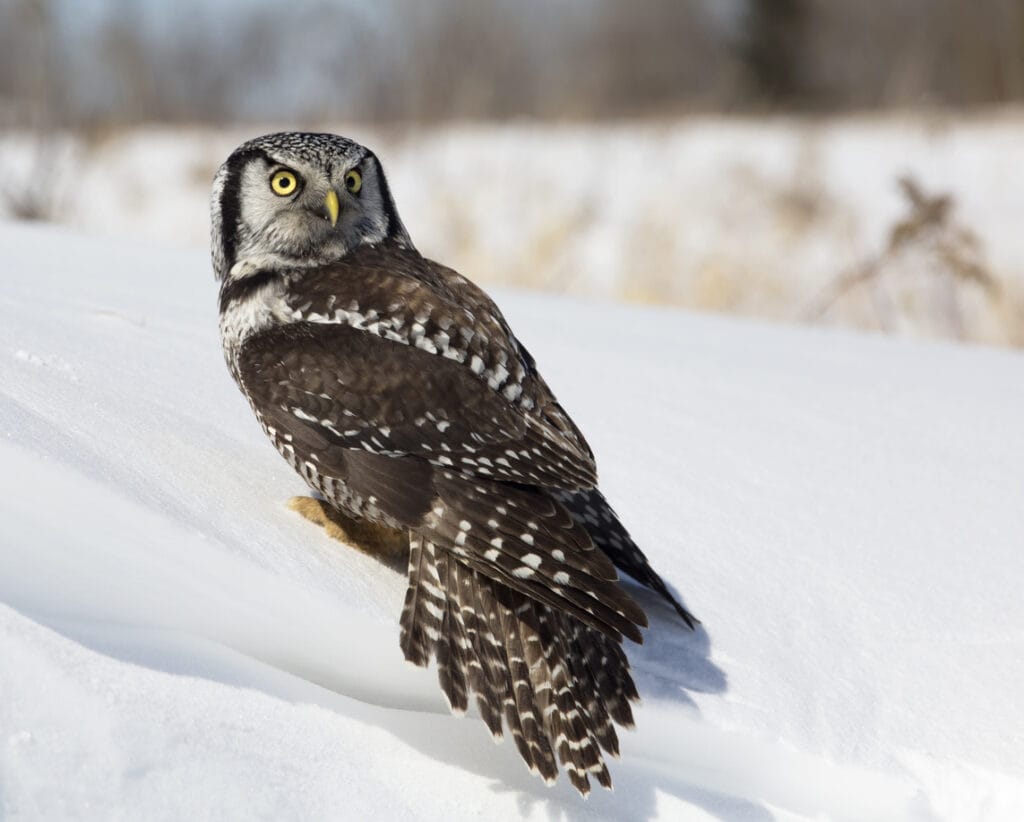
- Scientific name: Surnia ulula
- Length: 14 to 17 in
- Wingspan: 18 in
- Weight: 0.47-0.86 lb
Although it’s an owl, the Surnia ulula’s behavior can sometimes mimic that of a hawk, especially as it hovers over its prey before finally swooping down in very graceful motions.
They don’t rely on auditory senses for their hunting like most owls. Instead, they track their prey visually.
Surprisingly enough, more and more NorthernHawk Owls sightings have been recorded recently.
You can expect to see the Northern Hawk Owl in Washington around the winter season, especially around Manning Provincial Park.
The males of the Surnia ulula species have a quite melodic hoot, with soft pitch transitions. So, keep your ears out for this distinct tune!
6. The Burrowing Owl
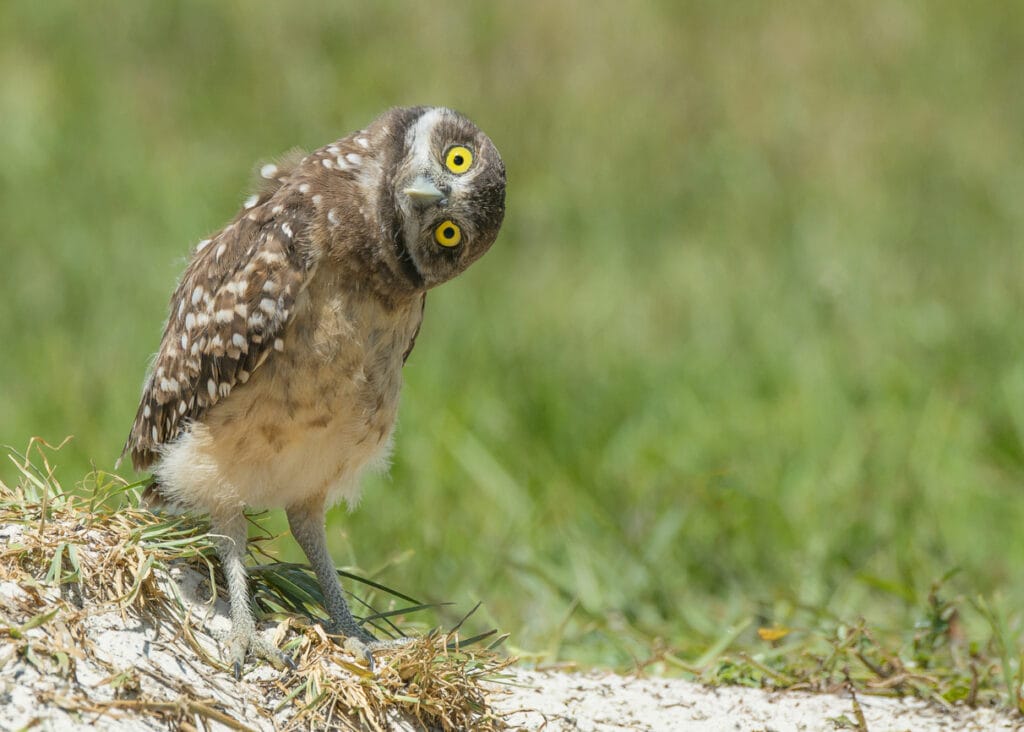
- Scientific name: Athene cunicularia
- Length: 7.5-10 in
- Wingspan: 10 in
- Weight: 0.33 lb
Unlike other owl species, the Burrowing Owls hardly ever hide among trees. Instead, they live underground.
Because of its preferred choice of habitat, it mostly feeds on beetles, insects, and other crawlers.
That’s not all they eat, though.
Sometimes, the owls will sneak out at night and snatch prey from any water bodies near their dens.
Sadly, the species isn’t very common, and you have to visit open grassy spaces in eastern Washington to have any luck at spotting the Burrowing Owl.
7. The Barn Owl

- Scientific name: Tyto alba
- Length: 12.6-15.7 in
- Wingspan: 42.1-43.31 in
- Weight: 1.375 lb
When you look at pictures of the Tyto alba, you immediately get why it’s sometimes called the Ghost Owl. The pale gray face, dark glossy eyes, and spotted chest tie the look together.
To make things even more ghost-like, this owl’s hissing almost sounds like an exaggerated scream!
But make no mistake.
The Tyto alba can be a silent predator since it’s capable of moving its wings without even as much as a “swoosh” sound.
Although if you want to spot the Ghost Owl, Grays Harbor County is your best shot. This species doesn’t migrate, so you have equal chances of finding it all year round.
8. The Pygmy Owls
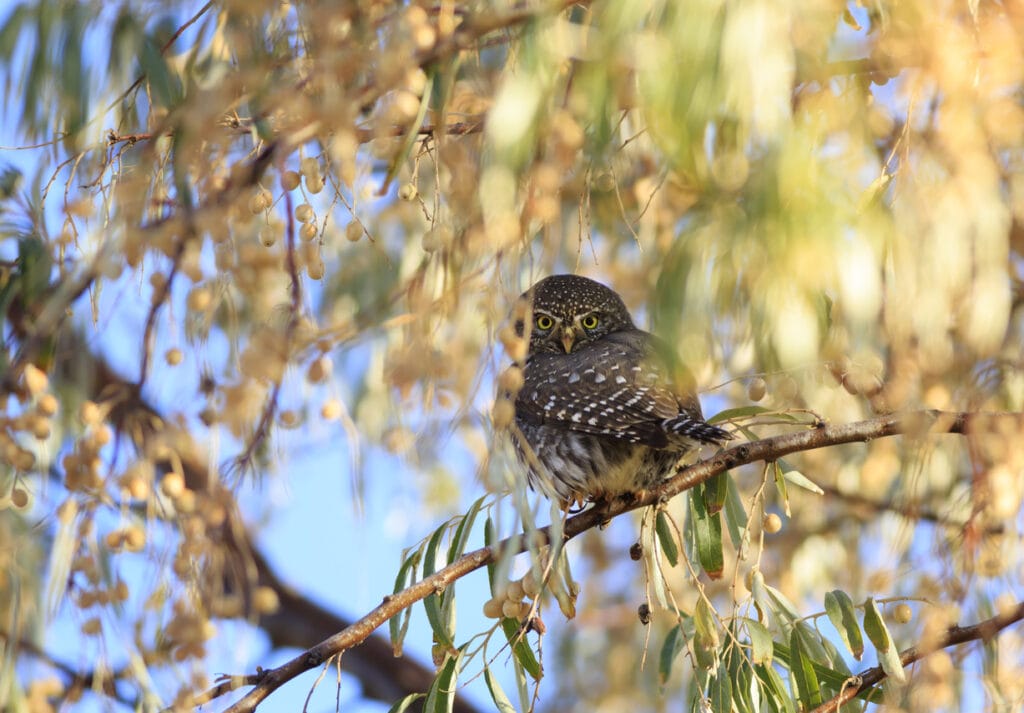
- Scientific name: Glaucidium californicum and G.brasilianum
- Length: 5.9-7 in
- Wingspan: 14.5-15 in
- Weight: 0.1-0.2 lb
There are a couple of varieties of the Glaucidium Owls. However, both the Ferruginous and the Northern Pygmies are widely available all over Washington, especially the mountain ranges.
Most animals know not to mess with the Ferruginous Pygmies, thanks to the fake eye patterns on the back of their heads.
They’re quite the chatterbox, too.
Once Pygmies get in the mood to hoot, they can keep going for a while in what might seem like a morse-code-encoded message!
Plus, if you hate having to lurk at night to watch some owls, you’re in luck. The Northern Pygmy can be easily spotted during the day.
9. The Tengmalm’s Owl

- Scientific name: Aegolius funereus
- Length: 7.8-11.1 in
- Wingspan: 21.65 to 24.41 in
- Weight: 0.42 lb
The Aegolius funereus (often referred to as the Boreal Owl) is strikingly similar to the Northern Saw-Whet but way shyer and hard to spot.
Although the Aegolius owls are already a rare breed in Washington, they also prefer mountain ranges, making their sightings that much harder.
While it might be hard to see them, you might be able to hear their hoots.
The interesting part about Tengmalm’s Owls is how easy it is to tell the gender apart just by their hooting sounds.
Their communication seems a lot like a low whistle, but you can still notice that the female hoot is usually high-pitched and shorter, almost like a quick whip.
10. The Barred Owl
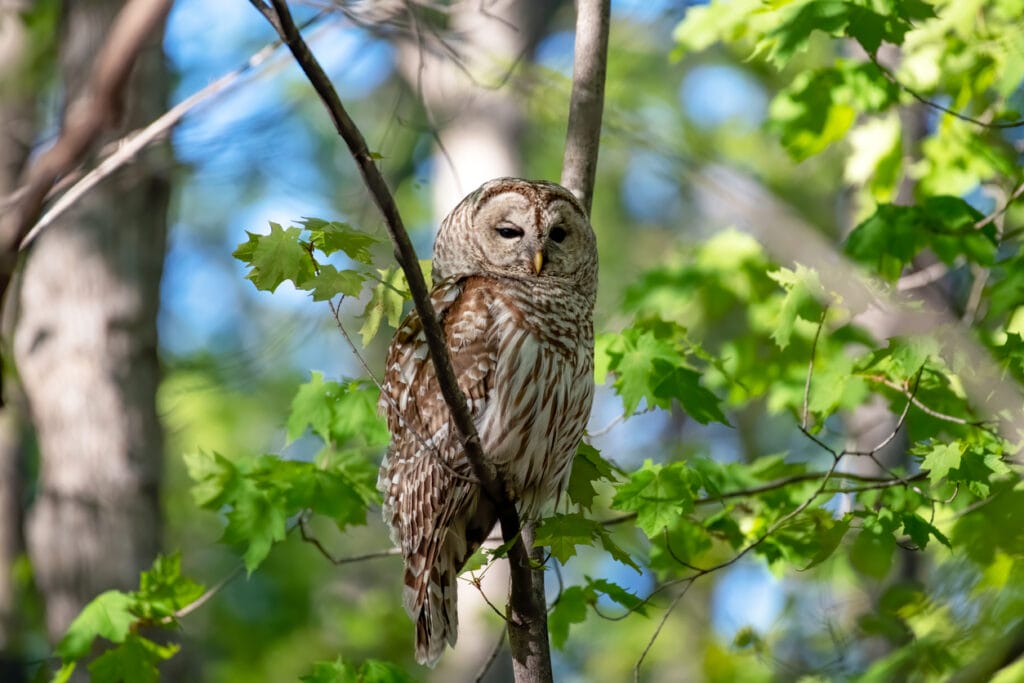
- Scientific name: Strix varia
- Length: 21 in
- Wingspan: 43 in
- Weight: 0.5 lb
For a Washington birdwatcher, the large Barred Owl is probably the first and easiest sighting ever since they’re hands down, the most common breed there.
Did you know that their plumage color depends on their diet? Yes, owls that fest mainly on crayfish might end up with a pink-ish chest.
Author Note: Although Barred Owls are mostly calm-tempered, in a group, they might be terrifying.
Once the group starts cawing together, it can come off as a human laughing maniacally off at a distance.
It’s also not unheard of for a young Barred Owl to occasionally attack a human when it senses that its territory is in danger.
11. The Short-eared Owl

- Scientific name: Asio flammeus
- Length: 13-17 in
- Wingspan: 35-40 in
- Weight: 0.45-1.04 lb
As you might have guessed, this species has a particularly short ear tuft that’s only really visible when the owl gets excited.
To attract a mate during the breeding season, the male owls perform a courtship flight display while hooting rhythmically.
The flame-like plumage looks spectacular in flight!
The Short-eared Owl is often spotted in Canada and the Northern part of the United States, especially when it gets warmer.
If you’re lucky enough to come across one of those, hang tight in your place for a second sighting. They often do return trips using the same route.
12. The Great Gray Owl

- Scientific name: Strix nebulosa
- Length: 24-33 in
- Wingspan: 4 ft, 8 in
- Weight: 2.42 lb
With a perfectly round head and small sunken eyes, the Great Gray Owl has an oddly piercing stare.
But the owl’s eyes aren’t the most interesting thing about it. It also happens to be one of the largest owls in North America!
Thankfully, the Strix nebulosa population is abundant and not at risk.
Author Note: During the winter, the Great Gray Owls mostly reside in forest areas, with a particular focus on coniferous trees.
They show up irregularly during the colder months between December and March in the Blue Mountains, Puget Trough, or Okanogan Highlands.
13. The Saw-whet Owl

- Scientific name: Aegolius acadicus, fam. Strigidae
- Length: 7.5 in
- Wingspan: 16.5-19 in
- Weight: 0.14-0.33 lb
While some owl species can look scary or piercing, the Saw-whet has an adorable little face that looks like something out of a kid’s cartoon!
The oversized head on a small body fits the stereotypical owl figure. The creamy-brown plumage and “Y” shaped white eyebrows fit this description, too.
For an easy sighting, we recommend the Blue Mountains.
You have more chances of spotting the Saw-whet Owl during the summer. As soon as it gets cold, they start moving down to the south.
Since they camouflage well into tree barks, you have to rely on your ears to track them down. However, their hoot is less melodic than other species, and it often feels too shrill.
14. The Flammulated Owl

- Scientific name: Psiloscops flammeolus
- Length: 6 in
- Wingspan: 14 in
- Weight: 10.13 lb
The Psiloscops flammeolus is an east-side Washintogn owl species known for its dark eyes and flame-striped plumage.
Proportionally to its small body, the Flammulated Owl’s diet is mainly composed of insects and beetles.
Don’t let the scrawny figure fool you, though.
Every now and then, they can pick up medium-sized rodents, which is actually impressive when you consider how small the owls’ bodies are.
One other notable feature about the Flammulated Owls is that they make deep and frequent hoots during the day, which makes tracking them a bit easier.
15. The Spotted Owl

- Scientific name: Strix occidentalis
- Length: 1.5 ft
- Wingspan: 4 ft
- Weight: 1.25 lb
The Strix occidentalis is yet another dark-eyed owl that prefers to hide from the main human population.
Top Tip: It’s easy to confuse them with the Barred Owls. However, you can tell them apart by noticing if the chest plumage is striped or spotted.
Unfortunately, the Spotted Owl is endangered, and only 2,000 pairs remain worldwide.
In fact, the Barred Owls compete with Strix occidentalis over habitat and prey, but the species is most endangered as a result of deforestation.
It used to be easy to see the species during the breeding season in the Puget Lowlands. Today, their population is limited to national parks like Mount Rainier.
Final Thoughts
So, here’s a list of 15 captivating owls in Washington State and where you can spot them!
Some owls are common in Washington all year round, while others are only there seasonally. The trick is knowing what breed to expect depending on the weather and location.
We hope you enjoyed this guide on the common owls in Washington State. Get some binoculars and enjoy your birdwatching!
FAQ
To find out where recent sightings of owls have been, try eBird. You can search for the latest sightings or particular species or what has been seen in a certain area.
Most of the owls on our list are reasonably common in Washington State.
Many of the owls on our list can be found in the following areas: Skagit Wildlife Area, Discovery Park, Olympic National Park, Mount Rainier National Park, Billy Frank Jr. Nisqually National Wildlife Refuge, Wenas.





